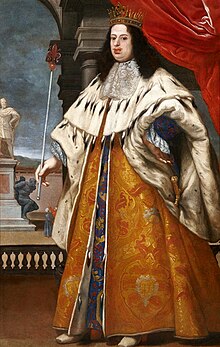Cosimo III de' Medici, Grand Duke of Tuscany
| Cosimo III | |||||
|---|---|---|---|---|---|

Cosimo in granducal robes, with Tuscan regalia
|
|||||
| Grand Duke of Tuscany | |||||
| Reign | 23 May 1670 – 31 October 1723 | ||||
| Predecessor | Ferdinando II | ||||
| Successor | Gian Gastone I | ||||
| Born | 14 August 1642 Pitti Palace, Florence, Tuscany |
||||
| Died | 31 October 1723 (aged 81) Pitti Palace, Florence, Tuscany |
||||
| Burial | Basilica of San Lorenzo, Tuscany | ||||
| Consort | Marguerite Louise d'Orléans | ||||
| Issue Detail |
Ferdinando, Grand Prince of Tuscany Anna Maria Luisa, Electress Palatine Gian Gastone, Grand Duke of Tuscany |
||||
|
|||||
| House | House of Medici | ||||
| Father | Ferdinando II de' Medici | ||||
| Mother | Vittoria Della Rovere | ||||
| Religion | Roman Catholicism | ||||
| Full name | |
|---|---|
| Cosimo de' Medici |
|
Styles of Cosimo III de' Medici, Most Serene Grand Duke of Tuscany |
|
|---|---|
 |
|
| Reference style | His Royal Highness |
| Spoken style | Your Royal Highness |
| Alternative style | Sir |
Cosimo III de' Medici (14 August 1642 – 31 October 1723) was the penultimate Medici Grand Duke of Tuscany. He reigned from 1670 to 1723, and was the elder son of Grand Duke Ferdinando II. Cosimo's 53-year-long reign, the longest in Tuscan history, was marked by a series of ultra-reactionary laws which regulated prostitution and banned May celebrations. His reign also witnessed Tuscany's deterioration to previously unknown economic lows. He was succeeded by his elder surviving son, Gian Gastone, when he died, in 1723.
He married Marguerite Louise d'Orléans, a cousin of Louis XIV. The marriage was solemnized by proxy in the King's Chapel at the Louvre, on Sunday, 17 April 1661. It was a marriage fraught with tribulation. Marguerite Louise eventually abandoned Tuscany for the Convent of Montmartre. Together, they had three children: Ferdinando in 1663, Anna Maria Luisa, Electress Palatine, in 1667, and Gian Gastone, the last Medicean ruler of Tuscany, in 1671.
In later life, he attempted to have Anna Maria Luisa recognised as the universal heiress of Tuscany, but Charles VI, Holy Roman Emperor, would not allow it because Florence was nominally an imperial fief, and he felt he alone could alter the Tuscan laws of succession. All Cosimo's efforts to salvage the plan foundered, and in 1737, upon his younger son's death, Tuscany passed to the House of Lorraine.
Cosimo de' Medici was born on 14 August 1642, the eldest surviving son of Vittoria della Rovere of Urbino, and Ferdinando II de' Medici, Grand Duke of Tuscany. Their previous two children had died shortly after birth. Grand Duke Ferdinando wished to give his son the finest scientific education available, but the pious Grand Duchess Vittoria opposed. The latter got her way. Volunnio Bandinelli, a Sienese theologian, was appointed Cosimo's tutor. His character was analogous to the Grand Duchess's.
...
Wikipedia
